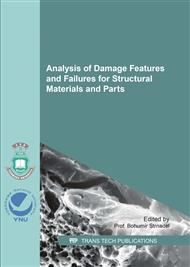p.99
p.105
p.110
p.116
p.122
p.128
p.134
p.138
p.144
Mechanics of Herbert Pendulum Hardness Tester and its Application
Abstract:
The knowledge of classical mechanics gives deeper insight into the Herbert hardness tester applicability for material testing. Elastic materials with low friction presence between contact surfaces are supposed to be investigated in this study. Firstly the dynamics approach is used to obtain simplified solution of swing angle. Then a new solution of the problem is gained by means of an energy approach. Slight decrease of the swing angle is predicted by the new solution as also shown in experiments. After comparison of both solutions a new formulae useful for evaluation of rolling resistance coefficient is applied for measurements performed on some metallic materials and artificial sapphire. Rolling resistance coefficients obtained by the way are always less than maximal estimated value.
Info:
Periodical:
Pages:
122-127
Citation:
Online since:
June 2017
Authors:
Keywords:
Price:
Сopyright:
© 2017 Trans Tech Publications Ltd. All Rights Reserved
Share:
Citation:


